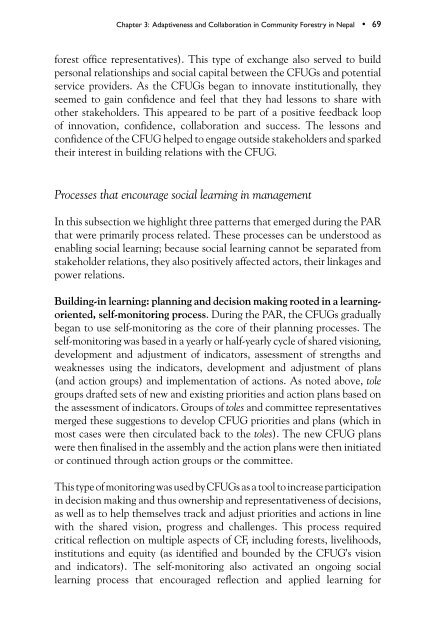Adaptive collaborative management of community forests in Asia ...
Adaptive collaborative management of community forests in Asia ...
Adaptive collaborative management of community forests in Asia ...
Create successful ePaper yourself
Turn your PDF publications into a flip-book with our unique Google optimized e-Paper software.
Chapter 3: <strong>Adaptive</strong>ness and Collaboration <strong>in</strong> Community Forestry <strong>in</strong> Nepal • 69<br />
forest <strong>of</strong>fice representatives). This type <strong>of</strong> exchange also served to build<br />
personal relationships and social capital between the CFUGs and potential<br />
service providers. As the CFUGs began to <strong>in</strong>novate <strong>in</strong>stitutionally, they<br />
seemed to ga<strong>in</strong> confidence and feel that they had lessons to share with<br />
other stakeholders. This appeared to be part <strong>of</strong> a positive feedback loop<br />
<strong>of</strong> <strong>in</strong>novation, confidence, collaboration and success. The lessons and<br />
confidence <strong>of</strong> the CFUG helped to engage outside stakeholders and sparked<br />
their <strong>in</strong>terest <strong>in</strong> build<strong>in</strong>g relations with the CFUG.<br />
Processes that encourage social learn<strong>in</strong>g <strong>in</strong> <strong>management</strong><br />
In this subsection we highlight three patterns that emerged dur<strong>in</strong>g the PAR<br />
that were primarily process related. These processes can be understood as<br />
enabl<strong>in</strong>g social learn<strong>in</strong>g; because social learn<strong>in</strong>g cannot be separated from<br />
stakeholder relations, they also positively affected actors, their l<strong>in</strong>kages and<br />
power relations.<br />
Build<strong>in</strong>g-<strong>in</strong> learn<strong>in</strong>g: plann<strong>in</strong>g and decision mak<strong>in</strong>g rooted <strong>in</strong> a learn<strong>in</strong>goriented,<br />
self-monitor<strong>in</strong>g process. Dur<strong>in</strong>g the PAR, the CFUGs gradually<br />
began to use self-monitor<strong>in</strong>g as the core <strong>of</strong> their plann<strong>in</strong>g processes. The<br />
self-monitor<strong>in</strong>g was based <strong>in</strong> a yearly or half-yearly cycle <strong>of</strong> shared vision<strong>in</strong>g,<br />
development and adjustment <strong>of</strong> <strong>in</strong>dicators, assessment <strong>of</strong> strengths and<br />
weaknesses us<strong>in</strong>g the <strong>in</strong>dicators, development and adjustment <strong>of</strong> plans<br />
(and action groups) and implementation <strong>of</strong> actions. As noted above, tole<br />
groups drafted sets <strong>of</strong> new and exist<strong>in</strong>g priorities and action plans based on<br />
the assessment <strong>of</strong> <strong>in</strong>dicators. Groups <strong>of</strong> toles and committee representatives<br />
merged these suggestions to develop CFUG priorities and plans (which <strong>in</strong><br />
most cases were then circulated back to the toles). The new CFUG plans<br />
were then f<strong>in</strong>alised <strong>in</strong> the assembly and the action plans were then <strong>in</strong>itiated<br />
or cont<strong>in</strong>ued through action groups or the committee.<br />
This type <strong>of</strong> monitor<strong>in</strong>g was used by CFUGs as a tool to <strong>in</strong>crease participation<br />
<strong>in</strong> decision mak<strong>in</strong>g and thus ownership and representativeness <strong>of</strong> decisions,<br />
as well as to help themselves track and adjust priorities and actions <strong>in</strong> l<strong>in</strong>e<br />
with the shared vision, progress and challenges. This process required<br />
critical reflection on multiple aspects <strong>of</strong> CF, <strong>in</strong>clud<strong>in</strong>g <strong>forests</strong>, livelihoods,<br />
<strong>in</strong>stitutions and equity (as identified and bounded by the CFUG’s vision<br />
and <strong>in</strong>dicators). The self-monitor<strong>in</strong>g also activated an ongo<strong>in</strong>g social<br />
learn<strong>in</strong>g process that encouraged reflection and applied learn<strong>in</strong>g for
















